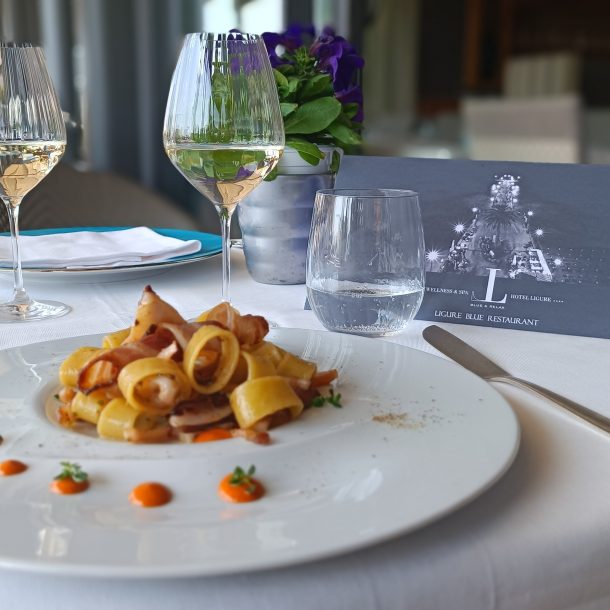
Close
Il fascino della Valle Arroscia è racchiuso nella bellezza di paesaggi dal sapore alpino,
nella semplicità della gente e della sua “cucina bianca” fatta di ingredienti poveri ma nutrienti.
Il Torrente Arroscia nasce dalle alture del Passo della Guardia a oltre 2.000 metri e solca tutta la vallata, percorre quasi 40 chilometri per poi unirsi al torrente Neva e creare il fiume Centa che si getta nel Mar Ligure ad Albenga. Sul suo corso si snoda la Valle Arroscia, ultimo lembo di Liguria e passaggio obbligato per raggiungere il Piemonte.
Risalendo la vallata partendo da Ortovero per arrivare al Col di Nava si capisce subito che nel corso dei secoli questa è stata una delle principali vie di comunicazione tra la Liguria e il Piemonte. Il primo tratto presenta una dolce salita e, a mano a mano, il paesaggio cambia. Arrivati a Pieve di Teco la salita si fa più dura e in pochi minuti si può arrivare a Col di Nava e scendere ad Ormea, oppure salire fino a Monesi e da qui percorrere l’Antica Via del Sale fino a Limone Piemonte tra le maestose montagne delle Alpi Liguri.
L’Alta Valle Arroscia conserva un ambiente tra i meglio preservati di tutta la Liguria. Qui è possibile ammirare non solo una natura incontaminata come la faggeta del bosco di Rezzo, i larici del Bosco delle Navette, le spettacolari cascate dell’Arroscia, ma anche peculiarità artistiche come la splendida strada che attraversa Pieve di Teco e i suoi portici.
La vera e propria porta della Vallata è Ranzo, un piccolo borgo di poco più di 500 anime suddiviso in una manciata di borgate. Ranzo è celebre per l’oliva taggiasca e il vino Pigato, e per aver dato i natali alla famiglia dei Guido, artisti attivi tra la fine del XV e l’inizio del XVI secolo.
Poco più avanti si incontra Vessalico, borgo di fondovalle che conserva numerosi edifici medievali. Nei campi intorno si coltiva il rinomato aglio, dal sapore intenso ma delicato, conservato nelle tipiche trecce, le reste.
Capoluogo dell’Arroscia è sicuramente Pieve di Teco con la sua storia e tradizioni, ma anche natura.
Basta osservare la strada che porta al borgo per capire la bellezza della Valle Arroscia, tra distese di vigneti e uliveti, che fanno del vino e dell’olio alcuni dei prodotti dell’eccellenza enogastronomica locale.
Infatti, oggi Pieve di Teco è un piccolo borgo diventato meta di turismo consapevole e curioso che giunge qui per vedere il centro storico con i suoi caratteristici portici ben curati, ma soprattutto per acquistare prodotti di altissima qualità.
Salendo ancora sulla strada principale arriviamo a Pornassio, culla dell’Ormeasco. Il comune è composto da frazioni fra cui quella di Col di Nava, l’ultimo borgo ligure prima di entrare in Piemonte.
Da sempre la storia di Nava è legata alla viabilità e al transito del passo e da questo valico passa tuttora la direttrice principale di collegamento tra il Ponente Ligure e il Piemonte. La sua importanza strategica nel corso dei secoli è testimoniata dai Forti di Nava: ben cinque strutture costruite in epoche diverse per controllare il passo. Il Forte Centrale, posto sulla vetta del Colle di Nava, è ancora oggi conservato in ottime condizioni ed è visitabile. Sono molto caratteristici i due fossati con i due ponti che un tempo fungevano da ponti levatoi.
A questo punto, non vi resta altro che avventurarvi nella meravigliosa Valle Arroscia, per concedervi una pausa dalla spiaggia di Alassio e dal sole e prendervi del tempo per godere a pieno di pura tranquillità in questa natura incontaminata.
Noi del Ligure siamo a disposizione per offrirvi i nostri migliori consigli.
© 2025 Hotel Ligure – P.IVA 00839570090 – CITR 009001 – ALB – 0035 – CIN IT009001A1MUAEI720 – CreaCity – Privacy Policy Cookie Policy